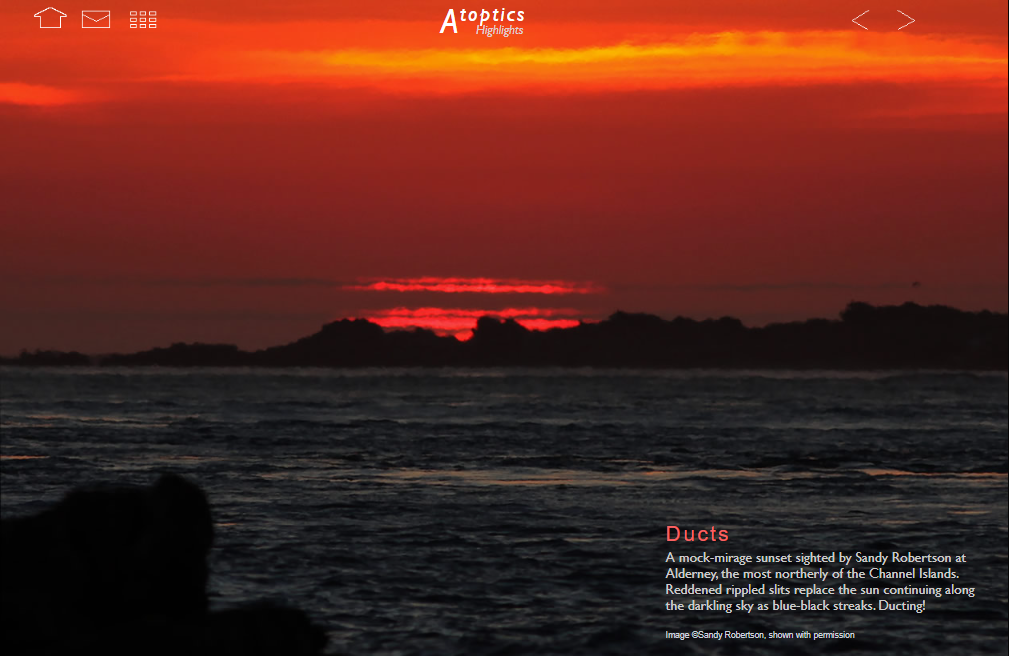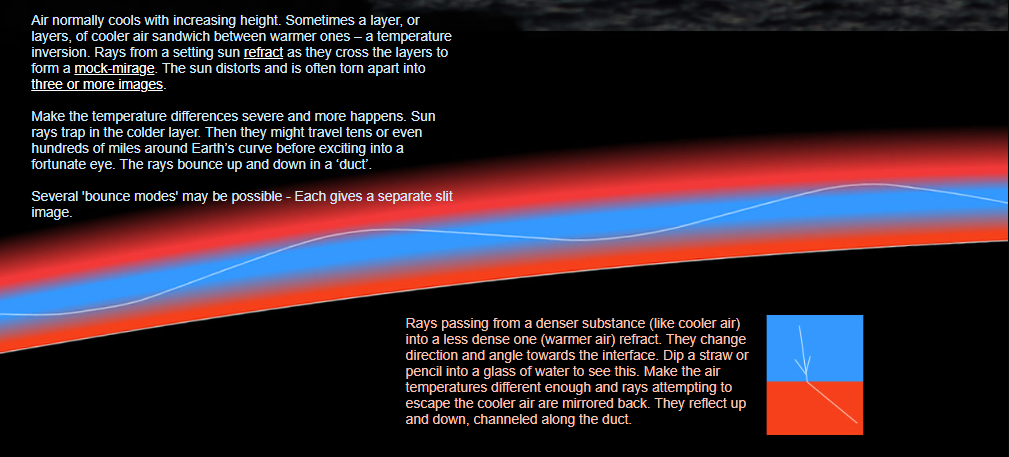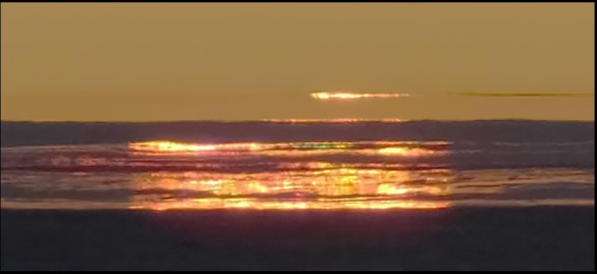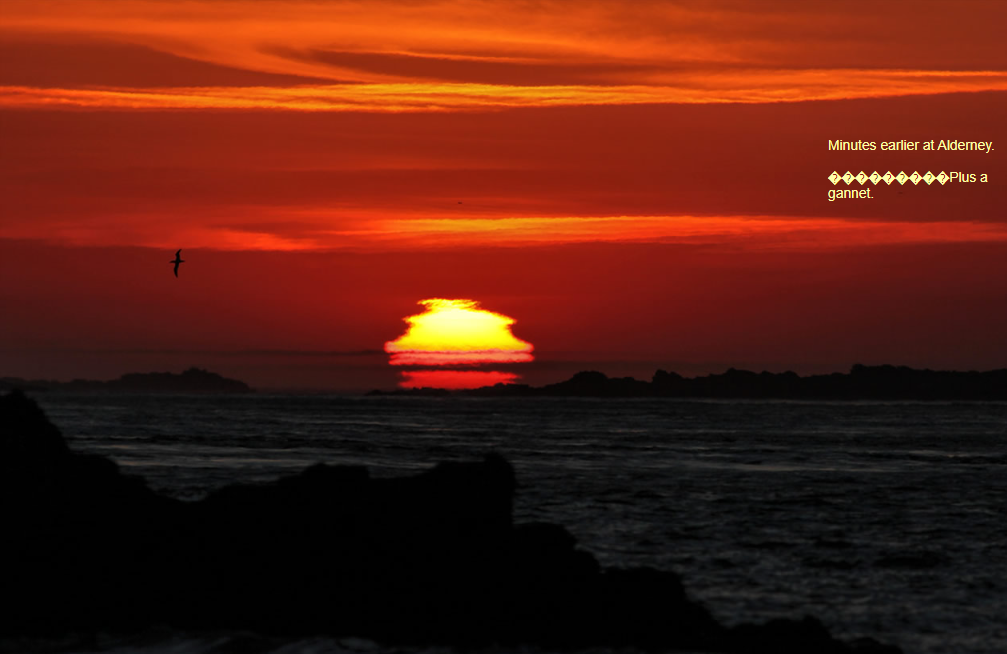Sunset Ray Ducting
Sunset Ray Ducting: Exploring the Phenomenon in Detail
Sunset ray ducting is a captivating atmospheric optics phenomenon that occurs when layers of cooler air become sandwiched between warmer air layers, creating a temperature inversion. This temperature difference causes the rays of the setting sun to refract as they cross these layers, resulting in the formation of a mock-mirage. The sun becomes distorted and can even be torn apart into multiple images. But what exactly happens during sunset ray ducting? Let's delve deeper into this intriguing phenomenon.
The Formation of Ducts
Air typically cools as it rises in the atmosphere. However, in certain conditions, cooler air layers can be trapped between warmer air masses, creating what is known as a temperature inversion. This inversion acts as a duct through which the rays of the sun can travel, leading to the formation of stunning optical effects during sunset. These effects are particularly pronounced when the temperature differences between the air layers are significant.
Bouncing Rays
When rays of light pass from a denser substance (such as cooler air) into a less dense one (warmer air), they undergo refraction, causing them to change direction and angle. To visualize this phenomenon, one can simply dip a straw or pencil into a glass of water and observe how it appears bent. Similarly, during sunset ray ducting, the rays of the sun attempting to escape the cooler air get mirrored back due to the temperature difference. This reflection causes the rays to bounce up and down, effectively channeling them along the duct.
Multiple Bounce Modes
Sunset ray ducting can result in several "bounce modes," each of which produces a separate slit image. As the rays of the sun traverse the duct, they can undergo multiple reflections and refractions, leading to the creation of stacked slits separated by darkness. These slits form a mesmerizing visual display that adds to the beauty of the sunset.
The Novaya Zemlya Effect
In extreme cases of ducting, a phenomenon known as the Novaya Zemlya Effect can occur. This effect causes the sun to appear to rise several minutes earlier than predicted or even days before its expected time, especially in polar regions. During the Novaya Zemlya Effect, the duct images of the sun become even more pronounced, with multiple stacked slits separated by darkness. This creates a surreal and awe-inspiring sight for observers lucky enough to witness it.
Observations and Photography
Sunset ray ducting has been observed and documented by numerous individuals worldwide. One such example is Sandy Robertson, who captured a stunning mock-mirage sunset at Alderney, one of the Channel Islands. Robertson's photograph showcases the reddened rippled slits that replace the sun, extending along the darkening sky as blue-black streaks. This captivating image exemplifies the mesmerizing beauty of sunset ray ducting.
Conclusion
Sunset ray ducting is a fascinating atmospheric optics phenomenon that occurs when cooler air layers become trapped between warmer air masses, creating a temperature inversion. This inversion acts as a duct through which the rays of the setting sun refract, resulting in the formation of mock-mirages and slit images. The Novaya Zemlya Effect, observed in extreme cases of ducting, amplifies these optical effects, creating surreal and breathtaking sights. The exploration and understanding of sunset ray ducting contribute to our appreciation of the wonders of our atmosphere and its ability to produce awe-inspiring visual displays.

Ducts
A mock-mirage sunset sighted by Sandy Robertson at Alderney, the most northerly of the Channel Islands. Reddened rippled slits replace the sun continuing along the darkling sky as blue-black streaks. Ducting!
Image @Sandy Robertson, shown with permission

Air normally cools with increasing height. Sometimes a layer, or layers, of cooler air sandwich between warmer ones - a temperature inversion. Rays from a setting sun refract as they cross the layers to form a mock-mirage. The sun distorts and is often torn apart into three or more images.
Make the temperature differences severe and more happens. Sun rays trap in the colder layer. Then they might travel tens or even hundreds of miles around Earth's curve before exciting into a fortunate eye. The rays bounce up and down in a 'duct'.
Several 'bounce modes' may be possible - Each gives a separate slit image.
Rays passing from a denser substance (like cooler air) into a less dense one (warmer air) refract. They change direction and angle towards the interface. Dip a straw or pencil into a glass of water to see this. Make the air temperatures different enough and rays attempting to escape the cooler air are mirrored back. They reflect up and down, channeled along the duct.

Novaya Zemlya Effect
Extreme ducting.
The sun appears to rise several minutes early or, in polar regions, days
before predicted.
The duct images are multiple stacked slits separated by darkness.
More on this image and the NZE.

Minutes earlier at Alderney.
Plus a gannet.
Note: this article has been automatically converted from the old site and may not appear as intended. You can find the original article here.
Reference Atmospheric Optics
If you use any of the definitions, information, or data presented on Atmospheric Optics, please copy the link or reference below to properly credit us as the reference source. Thank you!
-
<a href="https://atoptics.co.uk/blog/sunset-ray-ducting/">Sunset Ray Ducting</a>
-
"Sunset Ray Ducting". Atmospheric Optics. Accessed on November 26, 2024. https://atoptics.co.uk/blog/sunset-ray-ducting/.
-
"Sunset Ray Ducting". Atmospheric Optics, https://atoptics.co.uk/blog/sunset-ray-ducting/. Accessed 26 November, 2024
-
Sunset Ray Ducting. Atmospheric Optics. Retrieved from https://atoptics.co.uk/blog/sunset-ray-ducting/.